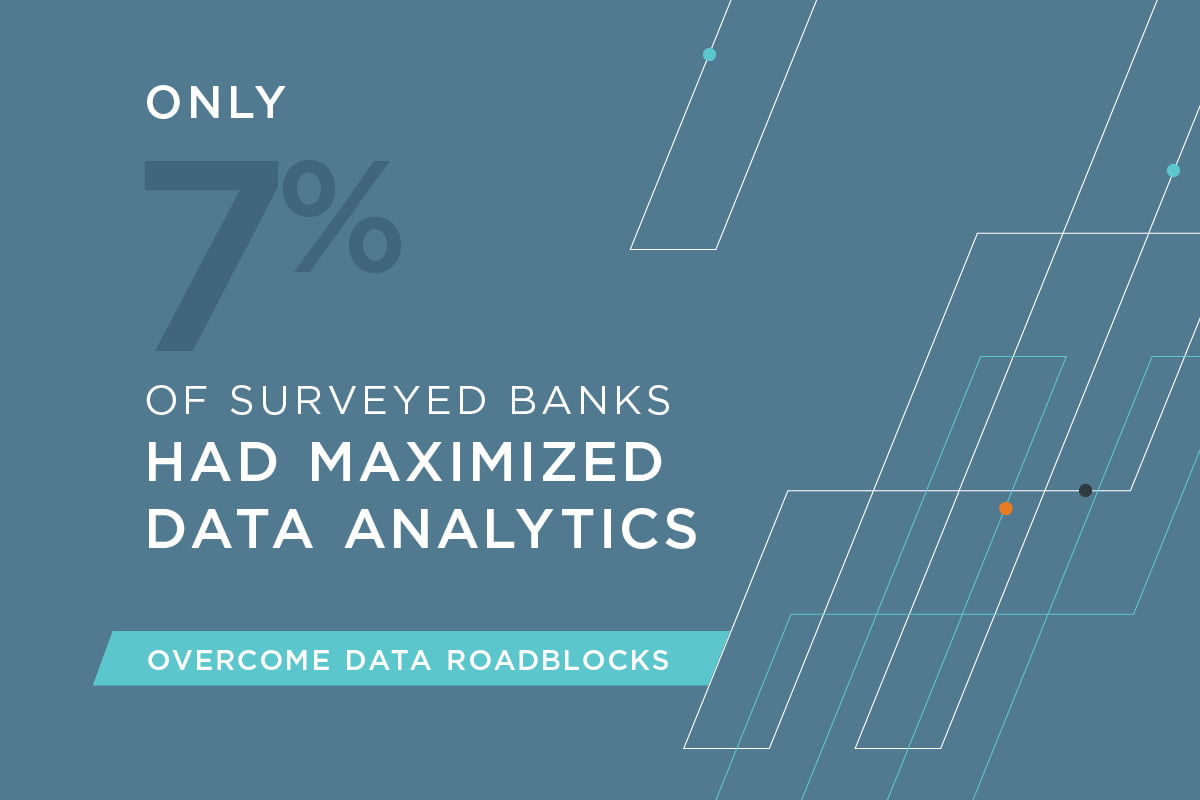The amount of data being created, stored, consumed, and copied is projected to reach 180 zettabytes by 2025. Financial institutions are among the leading industries with access to vast amounts of consumer data. Here are just a few of the important ways financial institution use data:
- Manage risk
- Forecast demand
- Identify behavior
- Develop predictive models
- Improve the customer experience
- Generate personalized marketing strategies
- Improve risk management
- Prevent fraud
The sheer volume of data can be overwhelming, making it challenging for financial institutions to know where to start.
Very few banks have this figured out. A McKinsey report found that only 7% of surveyed banks had maximized data analytics.
Here are five ways financial institutions can make the most of data to drive decisions, optimize strategies, and increase their bottom line.
1. Round Up All Your Data
To maximize your data, the first step is to collect and unify it. Financial institutions typically have access to a vast array of first-party data. It is their most valuable asset because it is unique to their business and collected directly from customers with their consent. First-party data can be gathered from a variety of sources, including:
- Customers
- Transactions
- Market
- Website analytics
2. Get a Clear Picture of Your Data
Organizing and structuring vast amounts of data is essential to make it easily accessible and understandable. To achieve this, marketers should start by creating a data inventory that includes:
- All data sources
- Where the data is stored
- How it’s structured
- How can it be used
- Who is responsible for managing it
By creating a data inventory, marketers can more easily identify data gaps and areas where data may be redundant or duplicated.
3. Let Your Data Do the Talking
By creating a data inventory, marketers can more easily identify data gaps and areas where data may be redundant or duplicated. Once there is a clear, organized, and comprehensive view of the data sources, the next step is to gather insights. By analyzing first-, second-, and third-party data, marketers gain insights into customer behavior, market trends, and more.
First-party data
First-party data, such as transactional and demographic data, can be used to identify behavioral patterns, like spending habits, to create targeted marketing campaigns and personalize offers.

Second-party data
Second-party data is collected by another organization and shared through a mutually beneficial business agreement. Second-party data can be useful in reaching an untapped market segment and provides valuable insights into the behavior and preferences of the target audience.
Third-party data
Third-party data is obtained from a variety of sources from a provider that specializes in collecting data. These providers organize data from multiple sources into categories so it’s easier, more accessible, and more relevant for companies to use for their specific marketing goals. For example, Vericast can organizes third-party data by demographics, lifestyle and interests. We can also aggregate observed consumer behaviors, such as in-store visits, purchases and coupon redemptions, to create segments of qualified consumers most likely to be in the market for specific products.
Combining first-, second-, and third-party sources enriches the overall data. It allows financial institutions can gain a more comprehensive view of their customers and the market, enabling them to make more informed and confident decisions.
4. Let Your Data Guide Your Actions
The insights gained from data analysis are valuable only if used to inform decision-making. Financial institutions can use data to target their marketing campaigns, segment their audiences by channel, and offer personalized products and services. This helps institutions make better use of valuable marketing dollars and increase their return on investment.
Data analytics drives many marketing use cases for financial institutions, such as:
- Personalization: Financial institutions can use data to build customer online spending profiles. They can then develop, for example, targeted and personalized credit-card marketing campaigns with incentives like travel rewards or travel insurance for frequent fliers.
- Cross-Selling: Financial institutions can use data for targeted cross-selling and promotions to increase revenue. They can combine multiple data sources, including first-party data previously siloed and third-party data that reveals which customers are in the market for financial services.
- Customer Experience: Big data can provide visibility into customer spending patterns, preferences, and online behaviors, which can be used to enhance the customer experience and strengthen relationships.
5. Review, Refine, Repeat
Finally, reviewing and repeating the process of gathering data, gaining insights and taking action is essential. No marketing campaign is money-well-spent unless it is evaluated and replicated. Relying on accurate pre- and post-campaign data gives marketers a better understanding of what’s working and what isn’t, enabling them to refine strategies over time.
Financial institutions can use metrics to evaluate their campaigns for customer engagement, conversion rates, and revenue generated. By regularly reviewing and analyzing this data, marketers can identify areas of success and improvement and make data-driven decisions to optimize strategies.
Steps You Can Take To Overcome Data Roadblocks
Conduct a Data Audit
One important aspect of reviewing and iterating is ensuring that the data being used is accurate and current. Financial institutions should regularly audit their data sources to ensure they collect, use, analyze, and maintain the correct data. They should also monitor changes in market trends, consumer behavior, and regulations and adjust the aforementioned processes accordingly.
Ensure Security and Compliance
Another important consideration is ensuring the data is safe and compliant with regulatory requirements. Financial institutions deal with sensitive customer information, must have robust data security measures in place to protect this data from breaches or cyberattacks, and must ensure that their data uses are permitted under applicable regulations.
Generate Broader, Deeper Insights
By generating comprehensive and valuable insights from data, financial services marketers can better understand their customers, improve their strategies, and ultimately drive business growth. In addition, allows marketers to measure the impact of their efforts more accurately. By tracking KPIs and analyzing data in real-time, marketers can quickly adjust their strategies and tactics to optimize their results.
Get a Return on Data Intelligence
Vericast’s Market Intelligence Platform enables real-time data visualization in a way never before possible. It leverages multiple data sources, including online and offline consumer behavior of financial products and services. And it uses artificial intelligence and advanced proprietary technology to provide unmatched insights into real-time consumer behavior at the household and neighborhood levels.
